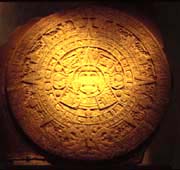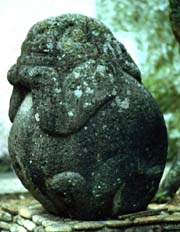|
Mesoamerican Artifacts II,
a Photo Gallery
The table below
presents views of a variety of artifacts from the ancient civilizations
of Mesoamerica. All the items are from Central Mexico, west of
the Isthmus of Tehuantepec. Special thanks to the National Museum of Anthropology
for permission to photograph for educational purposes. Each
thumbnail photo is a link to a larger version of the same photograph.
The Cannibalism
Paradigm: Assessing Contact Period Ethnohistorical Discourse
Teotihuacan Mural Art: Assessing the Accuracy of its Interpretation
Mesoamerican Archaeoastronomy:
Contemporary Understandings of Prehispanic Astronomic Knowledge
|

The largest Calender stone from Central Mexico hangs on the wall in
the National Museum of Anthropology in Mexico City.
|

Also in the museum, a calender stone is carved atop this monolith depicting
a teocalli, an ancient pyramid. The sides feature glyphs.
|

A model of the Aztec city of Tenochtitlan's central monument district
is on display in the same room of the museum as the two stone sculptures
shown above.
A large mural on the wall shows the city and causeways leading to the
great metropolis. The entire city was leveled by the Spanish invaders.
|

A gleeful expression is typical of a style of ceramic masks from the
Gulf Coast region of Mexico. This unique style of ecstatic faces are
featured on both masks and full figure sculptures.
|

A stone sculpture in a park in Misantla, Vera Cruz depicts a rabbit's
features emerging from a flattened spheroid. This image probably represents
the moon. The sculpture was removed from the nearby pyramid complex
of Los Idolos. Stone spheres, other carvings and a stela are known from
Los Idolos.
|

This page in the Codex Laud depicts a human seated on a Tree of Life
glyph.
The pictographic screen folds from Central Mexico and from the Maya
region are of distinct styles, although the calender, number and other
conventions are the same.
|


The so-called 'Xochipilli' stone sculpture in the Museo Nacional de
Antropología. Xochipilli is the numen of flowers in the prehistoric
tradition.
|

One of the original statutes found buried inside the Tula pyramid,
now on display in the National Museum of Anthropology.
|








